
Looney Tunes is an American animated franchise produced and distributed by Warner Bros. It began as a series of short films that originally ran from 1930 to 1969, concurrently with its partner series Merrie Melodies, during the golden age of American animation. Following a revival in the late 1970s, new shorts were released as recently as 2014. The two series introduced a large cast of characters, including Bugs Bunny, Daffy Duck, and Porky Pig. The term Looney Tunes has since been expanded to also refer to the characters themselves.

Merrie Melodies is an American animated comedy short film series distributed by Warner Bros. Pictures. It is the companion series to Looney Tunes, and featured many of the same characters as the former series. It originally ran from August 2, 1931, to September 20, 1969, during the golden age of American animation, though it had been revived in 1979, with new shorts sporadically released until June 13, 1997. Originally, Merrie Melodies placed emphasis on one-shot color films in comparison to the black and white Looney Tunes films. After Bugs Bunny became the breakout character of Merrie Melodies and Looney Tunes transitioned to color production in the early 1940s, the two series gradually lost their distinctions and shorts were assigned to each series randomly.

Golden Yeggs is a 1950 Warner Bros. Merrie Melodies short directed by Friz Freleng. The cartoon was released on August 5, 1950, and stars Daffy Duck and Porky Pig. A forerunner of the Rocky and Mugsy characters appear, with Rocky already in his present-day form.

Porky's Duck Hunt is a 1937 Warner Bros. Looney Tunes cartoon directed by Tex Avery. The cartoon was released on April 17, 1937, and stars Porky Pig and Daffy Duck, the latter making what is considered his first official appearance.
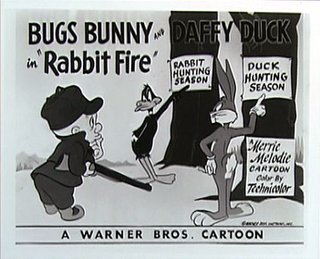
Rabbit Fire is a 1951 Looney Tunes cartoon starring Bugs Bunny, Daffy Duck, and Elmer Fudd. Directed by Chuck Jones and written by Michael Maltese, the cartoon is the first in Jones' "hunting trilogy"—the other two cartoons following it being Rabbit Seasoning and Duck! Rabbit, Duck! It is also the first cartoon to feature a feud between Bugs and Daffy. Produced by Edward Selzer for Warner Bros. Cartoons, Inc., the short was released to theaters on May 19, 1951 by Warner Bros. Pictures and is often considered among Jones' best and most important films.

I Love to Singa is a 1936 Warner Bros. Merrie Melodies animated cartoon directed by Tex Avery. The short was released on July 18, 1936.
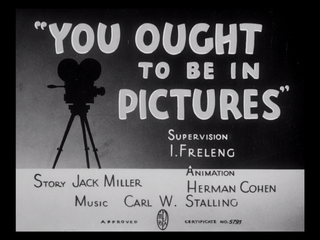
You Ought to Be in Pictures is a 1940 Warner Bros. Looney Tunes short film directed by Friz Freleng. The cartoon was released on May 18, 1940, and stars Porky Pig and Daffy Duck.

Looney Tunes Golden Collection: Volume 1 is a DVD box set that was released by Warner Home Video on October 28, 2003. The first release of the Looney Tunes Golden Collection DVD series, it contains 56 Looney Tunes and Merrie Melodies cartoons and numerous supplements. The set won the Classic Award at the Parents' Choice Awards.
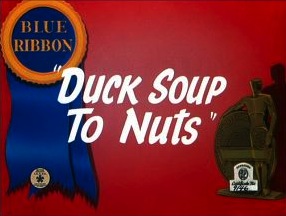
Duck Soup to Nuts is a 1944 Warner Bros. Looney Tunes cartoon directed by Friz Freleng. The cartoon was released on May 27, 1944, and stars Daffy Duck and Porky Pig.

Yankee Doodle Daffy is a Warner Bros. Looney Tunes theatrical cartoon short released on June 5, 1943, directed by Friz Freleng and written by Tedd Pierce. The short was the second Technicolor Looney Tunes entry to feature Porky Pig and Daffy Duck. It is also one of the handfuls of Looney Tunes and Merrie Melodies to have entered into the public domain.

A Corny Concerto is a 1943 Warner Bros. Merrie Melodies directed by Bob Clampett. The short was released on September 25, 1943, and stars Bugs Bunny, Porky Pig, Elmer Fudd and Daffy Duck.
Tick Tock Tuckered is a 1944 Warner Bros. Looney Tunes cartoon directed by Bob Clampett. The cartoon was released on April 8, 1944, and stars Porky Pig and Daffy Duck. This is a color remake of the cartoon Porky's Badtime Story (1937), with Daffy filling the role that was previously played by Gabby Goat. A gag from Friz Freleng's cartoon Notes to You (1941) was also reused as well, while a reference to The Dover Boys (1942) is briefly made.

Looney Tunes Golden Collection: Volume 4 is a DVD box set that was released by Warner Home Video on November 14, 2006.

Daffy Duck & Egghead is a 1938 Warner Bros. Merrie Melodies cartoon produced in 1937 and directed by Tex Avery. The cartoon was released on January 1, 1938, and stars Daffy Duck and Egghead.

Daffy Duck Hunt is a 1949 Warner Bros. Looney Tunes cartoon, directed by Robert McKimson. The cartoon was released on March 26, 1949, and stars Daffy Duck, Porky Pig and the Barnyard Dawg.

Swooner Crooner is a 1944 Warner Bros. Looney Tunes cartoon directed by Frank Tashlin. The short was released on May 6, 1944, and stars Porky Pig.
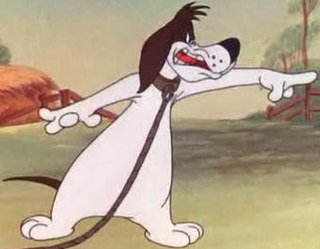
Barnyard Dawg is a Looney Tunes character. A feisty anthropomorphic basset hound, he is a friend and the archenemy of Foghorn Leghorn. He was created by Robert McKimson, who also created Foghorn, and was voiced by Mel Blanc. Dawg also feuds with other enemies as well like Henery Hawk, Daffy Duck and Sylvester. He appeared in 23 Golden Age–era Warner Bros. shorts.
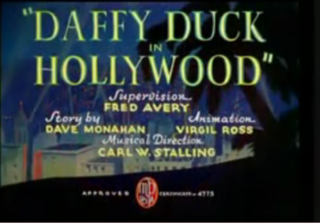
Daffy Duck in Hollywood is a 1938 Warner Bros. Merrie Melodies animated short directed by Tex Avery. The cartoon was released on December 12, 1938, and stars Daffy Duck. The short is Avery's last Daffy Duck cartoon.
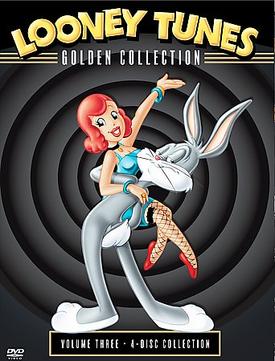
Looney Tunes Golden Collection: Volume 3 is a DVD box set from Warner Home Video that was released on October 25, 2005. It contains 60 Looney Tunes and Merrie Melodies theatrical short subject cartoons, nine documentaries, 32 commentary tracks from animators and historians, 11 "vintage treasures from the vault", and 11 music-only or music-and-sound-effects audio tracks.
Tom Turk and Daffy is a 1944 Warner Bros. Looney Tunes cartoon directed by Chuck Jones. The cartoon was released on February 12, 1944, and stars Porky Pig and Daffy Duck. Michael Maltese and Tedd Pierce are both the writers of the short, and are credited here as "The Staff".


















